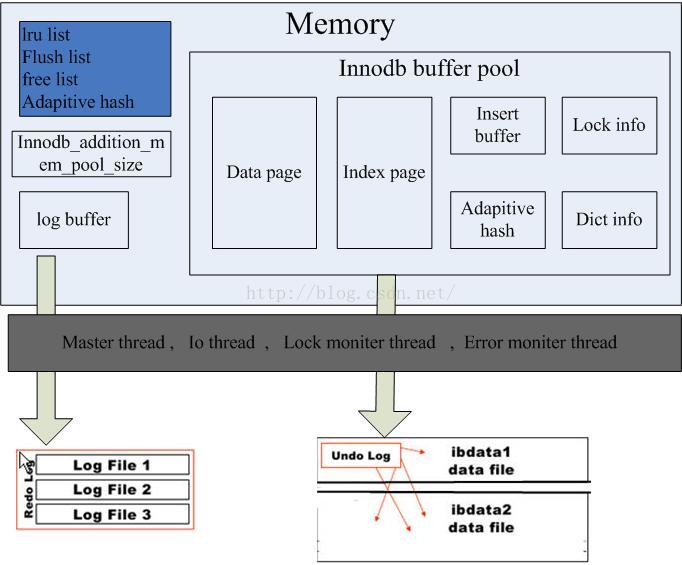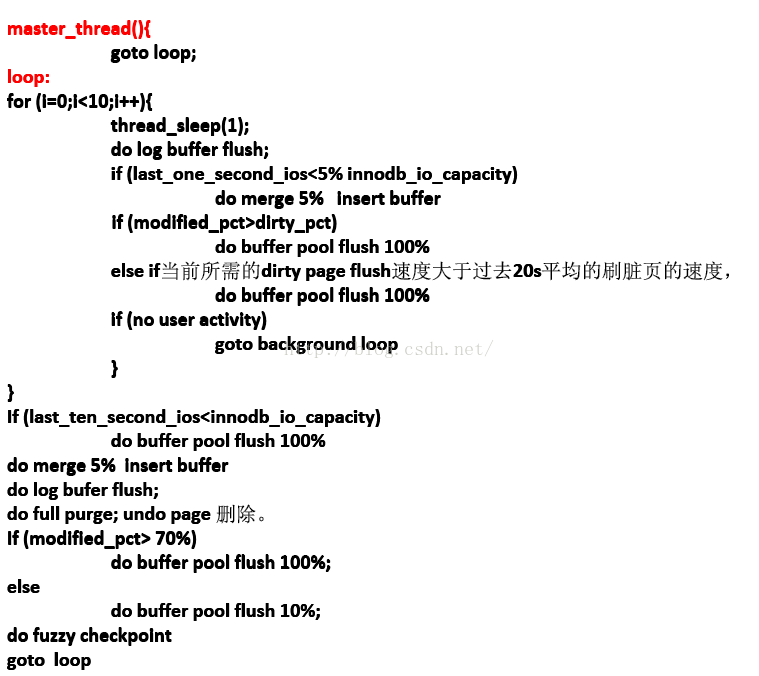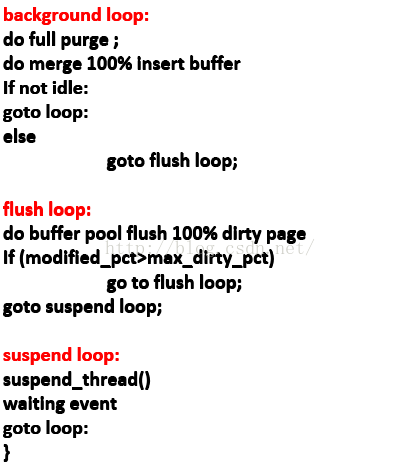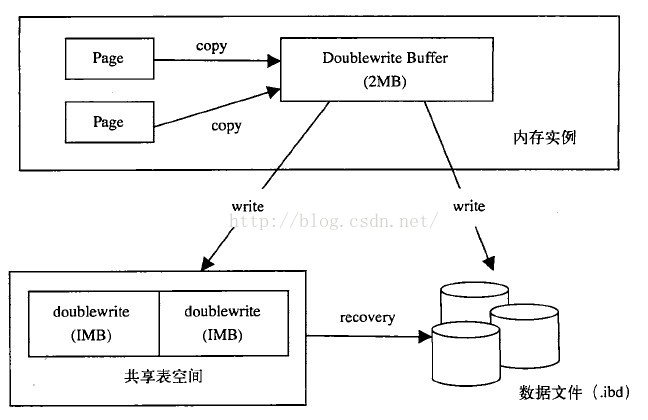概述
MySQL Study之--MySQL体系结构深入解析
MySQL体系架构

由连接池组件、管理服务和工具组件、sql接口组件、查询分析器组件、优化器组件、缓冲组件、插件式存储引擎、物理文件组成。mysql是独有的插件式体系结构,各个存储引擎有自己的特点。
MySQL内存结构:

Mysql 进程结构
Mysql不像oracle那样是通过多进程来完成其功能的。默认情况下,InnoDB存储引擎的后台线程有7个:
4个IO thread,
1个master thread,
1个锁(lock)监控线程,
1个错误监控线程;
在InnoDB Plugin版本开始增加了默认IO thread的数量,默认的read thread和write thread分别增大到了4个,并且不再使用innodb_file_ io_threads参数,而是分别使用innodb_read_io_threads和innodb_write_io_threads参数。
查看mysql thread:
mysql> show variables like 'innodb_%version%';
+----------------+-------+
| Variable_name | Value |
+----------------+-------+
| innodb_version | 1.2.4 |
+----------------+-------+
1 row in set (0.00 sec)mysql> show engine innodb status;
=====================================
150709 15:26:40 INNODB MONITOR OUTPUT
=====================================
Per second averages calculated from thelast 12 seconds
-----------------
BACKGROUND THREAD
-----------------
srv_master_thread loops: 0 srv_active, 0srv_shutdown, 804 srv_idle
srv_master_thread log flush and writes: 804
----------
SEMAPHORES
----------
OS WAIT ARRAY INFO: reservation count 2
OS WAIT ARRAY INFO: signal count 2
Mutex spin waits 0, rounds 0, OS waits 0
RW-shared spins 2, rounds 60, OS waits 2
RW-excl spins 0, rounds 0, OS waits 0
Spin rounds per wait: 0.00 mutex, 30.00RW-shared, 0.00 RW-excl
------------
TRANSACTIONS
------------
Trx id counter 5377
Purge done for trx's n:o
History list length 1
LIST OF TRANSACTIONS FOR EACH SESSION:
---TRANSACTION 0, not started
MySQL thread id 3, OS thread handle0x7f1656c75700, query id 5 localhost root init
show engine innodb status
--------
FILE I/O
--------
I/O thread 0 state: waiting for completedaio requests (insert buffer thread)
I/O thread 1 state: waiting for completedaio requests (log thread)
I/O thread 2 state: waiting for completedaio requests (read thread)
I/O thread 3 state: waiting for completedaio requests (read thread)
I/O thread 4 state: waiting for completedaio requests (read thread)
I/O thread 5 state: waiting for completedaio requests (read thread)
I/O thread 6 state: waiting for completedaio requests (write thread)
I/O thread 7 state: waiting for completedaio requests (write thread)
I/O thread 8 state: waiting for completedaio requests (write thread)
I/O thread 9 state: waiting for completedaio requests (write thread)
Pending normal aio reads: 0 [0, 0, 0, 0] ,aio writes: 0 [0, 0, 0, 0] ,
ibufaio reads: 0, log i/o's: 0, sync i/o's: 0
Pending flushes (fsync) log: 0; bufferpool: 0
283 OS file reads, 5 OS file writes, 5 OSfsyncs
0.00 reads/s, 0 avg bytes/read, 0.00writes/s, 0.00 fsyncs/s
-------------------------------------
INSERT BUFFER AND ADAPTIVE HASH INDEX
-------------------------------------
Ibuf: size 1, free list len 0, seg size 2,0 merges
merged operations:
insert 0, delete mark 0, delete 0
discarded operations:
insert 0, delete mark 0, delete 0
Hash table size 276707, node heap has 0buffer(s)
0.00 hash searches/s, 0.00 non-hashsearches/s
---
LOG
---
Log sequence number 1611537
Log flushed up to 1611537
Pages flushed up to 1611537
Last checkpoint at 1611537
0 pending log writes, 0 pending chkp writes
8 log i/o's done, 0.00 log i/o's/second
----------------------
BUFFER POOL AND MEMORY
----------------------
Total memory allocated 137363456; inadditional pool allocated 0
Dictionary memory allocated 39010
Buffer pool size 8192
Free buffers 8040
Database pages 152
Old database pages 0
Modified db pages 0
Pending reads 0
Pending writes: LRU 0, flush list 0 singlepage 0
Pages made young 0, not young 0
0.00 youngs/s, 0.00 non-youngs/s
Pages read 152, created 0, written 1
0.00 reads/s, 0.00 creates/s, 0.00 writes/s
No buffer pool page gets since the lastprintout
Pages read ahead 0.00/s, evicted withoutaccess 0.00/s, Random read ahead 0.00/s
LRU len: 152, unzip_LRU len: 0
I/O sum[0]:cur[0], unzip sum[0]:cur[0]
--------------
ROW OPERATIONS
--------------
0 queries inside InnoDB, 0 queries in queue
0 read views open inside InnoDB
Main thread process no. 2461, id139733873489664, state: sleeping
Number of rows inserted 0, updated 0,deleted 0, read 0
0.00 inserts/s, 0.00 updates/s, 0.00deletes/s, 0.00 reads/s
----------------------------
END OF INNODB MONITOR OUTPUT
[root@mysrv ~]# mysql -u root -p
Enter password:
Welcome to the MySQL monitor. Commands end with ; or g.
Your MySQL connection id is 3
Server version: 5.6.4-m7-log Sourcedistribution
Copyright (c) 2000, 2011, Oracle and/or itsaffiliates. All rights reserved.
Oracle is a registered trademark of OracleCorporation and/or its
affiliates. Other names may be trademarksof their respective
owners.
Type 'help;' or 'h' for help. Type 'c' toclear the current input statement.
mysql> show variables like'innodb_%io%';
+---------------------------------+---------+
| Variable_name | Value |
+---------------------------------+---------+
| innodb_additional_mem_pool_size | 8388608|
| innodb_io_capacity | 200 |
| innodb_read_io_threads | 4 |
| innodb_replication_delay | 0 |
| innodb_use_native_aio | ON |
| innodb_version | 1.2.4 |
| innodb_write_io_threads | 4 |
+---------------------------------+---------+
7 rows in set (0.01 sec)
后台线程主要作用有三个:
1. 刷新内存池中的数据,保证缓冲池中的内存缓存的是最近的数据
2. 将修改的数据文件刷新到磁盘文件
3. 在数据库发生异常情况下,保证InnoDB能恢复到正常运行状态
master thread的线程优先级别最高。其内部由几个循环(loop)组成:主循环(loop)、后台循环(backgroundloop)、刷新循环(flush loop)、暂停循环(suspend loop)。master thread会根据数据库运行的状态在loop、background loop、 flush loop和suspend loop中进行切换。loop称为主循环,因为大多数的操作都在这个循环中,其中有两大部分操作:每秒钟的操作和每10秒的操作.
Loop为主循环,如果没有用户活动,就切换到backgroundloop中,然后跳转会loop,如果还需要flush刷新,那就转到flush loop,如果在flush loop中也空闲,那就切换到suspend loop中,将master thread挂起等待事件的发生。
Mysql 进程结构


Loop:
每秒一次的操作包括:
日志缓冲刷新到磁盘,即使这个事务还没有提交(总是)。
合并插入缓冲(可能)。
至多刷新100个InnoDB的缓冲池中的脏页到磁盘(可能)。
如果当前没有用户活动,切换到background loop(可能)。
接着来看每10秒的操作,包括如下内容:
刷新100个脏页到磁盘(可能)。
合并至多5个插入缓冲(总是)。
将日志缓冲刷新到磁盘(总是)。
删除无用的Undo页(总是)。
刷新100个或者10%脏页到磁盘(总是)。
产生一个检查点(总是)。
Background loop会执行以下操作
删除无用的Undo页(总是)。
合并20个插入缓冲(总是)。
跳回到主循环(总是)。
不断刷新100个页,直到符合条件(可能,跳转到flush loop中完成)。
Mysql进程结构--控制磁盘io的参数
innodb_io_capacity
用来表示磁盘IO的吞吐量,默认值为200。对于刷新到磁盘的数量(脏缓冲),会按照innodb_io_capacity的百分比来刷新相对数量的页
在合并插入缓冲时,合并插入缓冲的数量为innodb_io_capacity数值的5%。
在从缓冲区刷新脏页时,刷新脏页的数量为innodb_io_capacity。
innodb_max_dirty_pages_pct
默认值为75%。加快脏页刷新频率,减少恢复时间,也可保证磁盘IO负载。
innodb_adaptive_flushing:
在innodbplugin中。该值影响每1秒刷新脏页的数量。原来的刷新规则是:如果脏页在缓冲池所占的比例小于innodb_max_dirty_pages_pct时,不刷新脏页。大于innodb_max_dirty_pages_pct时,刷新100个脏页,而innodb_adaptive_flushing参数的引入,InnoDB存储引擎会通过一个名为buf_flush_get_desired_flush_rate的函数判断产生重做日志的速度来判断最合适的刷新脏页的数量。因此,当脏页的比例小于innodb_max_dirty_pages_pct时,也会刷新一定量的脏页。
还有两个和mysql启动和关闭有关的参数
innodb_fast_shutdown
这个参数影响着innodb表的行为,该参数可设置为0,1,2
0: 表示当MySQL关闭时,InnoDB需要完成所有的full purge和merge insert buffer操作。耗时
比较长。
1: 是默认值。表示不需要完成full purge和merge insert buffer操作,但是在缓冲池中的一
些数据脏页会刷新到磁盘。
2: 表示不完成full purge和merge insert buffer操作,也不将缓冲池中的数据脏页写回到磁
盘,而是将日志写入到日志文件。MySQL下次启动时,会执行恢复操作。
innodb_force_recovery
影响InnoDB的恢复状况。默认为0,表示需恢复时执行所有的恢复操作。若不能有效恢复,则MySQL有可能宕机,错误信息会被写入错误日志文件。还有 1~6等不同值,根据
需要可以设置。
0 :正常的关闭和启动,不会做任何强迫恢复操作;
1 :跳过错误页,让mysqld服务继续运行。跳过错误索引记录和存储页,可以执行备份操作
2 :阻止InnoDB的主线程运行。清理操作时出现mysqld服务崩溃,则会阻止数据恢复操作;
3 :恢复的时候,不进行事务回滚;
4 :阻止INSERT缓冲区的合并操作。不做合并操作,为防止出现mysqld服务崩溃。不计算表的统计信息
5 :mysqld服务启动的时候不检查回滚日志:InnoDB引擎对待每个不确定的事务就像提交的事务一样;
6 :不做事务日志前滚恢复操作;
Mysql内存结构—buffer pool
InnoDB存储引擎内存主要由几个部分组成:缓冲池(bufferpool)、重做日志缓冲池(redo log buffer)以及额外的内存池(additional memory pool)
缓冲池是占内存最大的部分,用来存放各种数据的缓存。因为InnoDB的存储引擎的工作方式总是将数据库文件按页(每页16K)读取到缓冲池,然后按最近最少使用(LRU)的算法来保留在缓冲池中的缓存数据。如果数据库文件需要修改,总是首先修改在缓存池中的页(发生修改后,该页即为脏页),然后再按照一定的频率将缓冲池的脏页刷新(flush)到文件。
buffer pool是通过三种list来管理的:
1) free list
2) lru list
3) flush list
buffer pool中的最小单位是page,在innodb中定义三种page
1) free page :此page未被使用,此种类型page位于free链表中
2) clean page:此page被使用,对应数据文件中的一个页面,但是页面没有被修改,此种类型
page位于lru链表中
3) dirty page:此page被使用,对应数据文件中的一个页面,但是页面被修改过,此种类型page
位于lru链表和flush链表中
插入缓冲:
不是缓冲池的一部分,InsertBuffer是物理页的一个组成部分,它带来InnoDB性能的提高。根据B+算法(下文会提到)的特点,插入数据的时候会主键索引是顺序的,不会造成数据库的随机读取,而对于非聚集索引(即辅助索引),叶子节点的插入不再是顺序的了,这时需要离散地访问非聚集索引,插入性能在这里变低了。InnoDB引入插入缓冲,判断非聚集索引页是否在缓冲池中,如果在则直接插入;不在,则先放在插入缓冲区中。然后根据上述master thread中介绍的,会有一定的频率将插入缓冲合并。此外,辅助索引不能是唯一的,因为插入到插入缓冲时,并不去查找索引页的情况,否则仍然会造成随机读,失去插入缓冲的意义了。插入缓冲可能会占缓冲池中内存,默认也能会占到1/2,所以可以将这个值调小点,到1/3。通过IBUF_POOL_SIZE_PER_MAX_SIZE来设置,2表示1/2,3表示1/3。
两次写:
它带来InnoDB数据的可靠性。如果写失效,可以通过重做日志进行恢复,但是重做日志中记录的是对页的物理操作,如果页本身损坏,再对其进行重做是没有意义的。所以,在应用重做日志前,需要一个页的副本,当写入失效发生时,先通过页的副本来还原该页,再进行重做,这就是doublewire。
恢复数据=页副本+重做日志

Mysql内存结构—log buffer与管理池
日志缓冲:
日志缓冲将重做日志信息先放入这个缓冲区,然后按一定频率将其刷新到重做日志文件。该值一般不需要设置为很大,因为一般情况下每一秒钟就会将重做日志缓冲刷新到日志文件,因此我们只需要保证每秒产生的事务量在这个缓冲大小之内即可。
额外的内存池:
额外的内存池同样十分重要。在InnoDB存储引擎中,对内存的管理是通过一种称为内存堆(heap)的方式进行的,他是用于缓存InnoDB引擎的数据字典信息和内部数据结构,在对一些数据结构本身分配内存时,需要从额外的内存池中申请,当该区域的内存不够时,会从缓冲池中申请,若是mysqld服务上的表对象数量较多,InnoDB引擎数据量很大,且innodb_buffer_pool_size的值设置较大,则应该适当地调整innodb_additional_mem_pool_size的值。若是出现缓存区的内存不足,则会直接向操作系统申请内存分配,并且会向MySQL的error log文件写入警告信息。
binlog和redolog区别:
1) binary log,会记录所有与MySQL有关的日志记录,包括 Innodb、MyISAM、Heap等其他存储引
擎的日志而 innodb存储引擎的重做日志(redolog),只记录有关其本身的事务日志
2) 记录内容不同:
binary log:不管你将二进制日志文件的记录格式设置为STATEMENT,还是ROW,又或是
MIXED, 其记录的都是关于一个事务的具体操作内容.
redo log: 记录innodb 每个页的更改的物理情况
3)写入时间不同:
binary log:事务提交前进行记录
redo log :事物进行过程中,不断写入。
最后
以上就是正直太阳为你收集整理的mysql体系结构深入剖析_MySQL Study之--MySQL体系结构深入解析的全部内容,希望文章能够帮你解决mysql体系结构深入剖析_MySQL Study之--MySQL体系结构深入解析所遇到的程序开发问题。
如果觉得靠谱客网站的内容还不错,欢迎将靠谱客网站推荐给程序员好友。








发表评论 取消回复